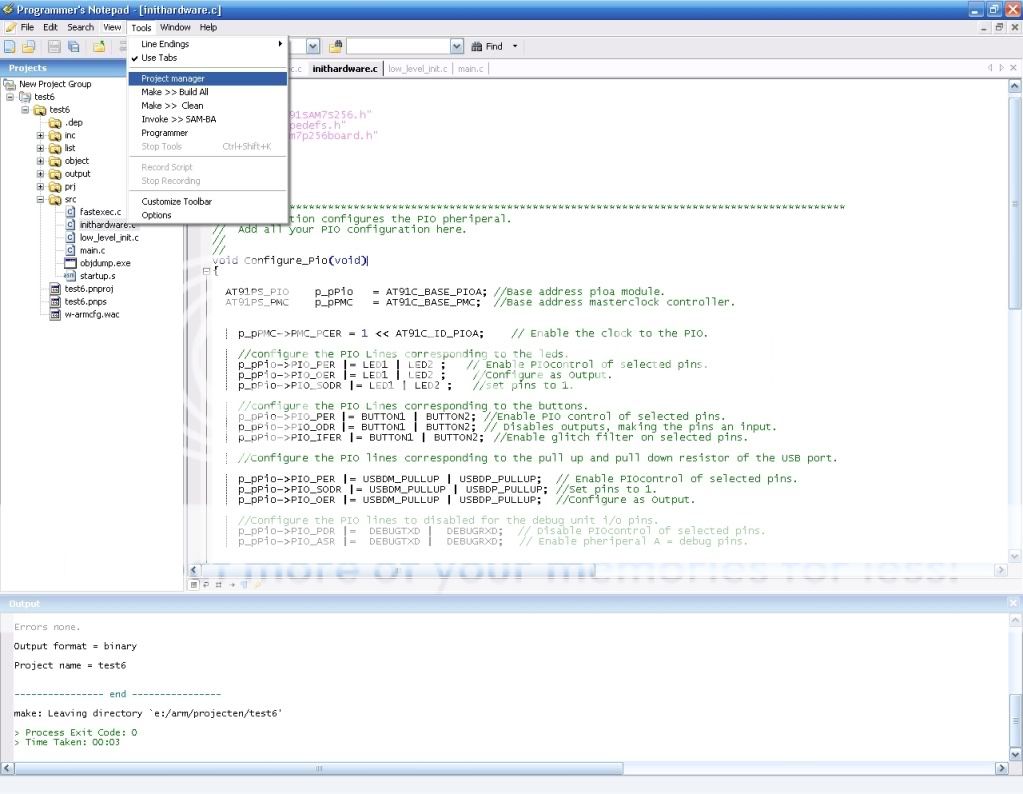- May 11, 2008
- 22,551
- 1,471
- 126
Are their people interested in testing a free opensource that is a handy tool when programming embedded ARM chips ? I am sure some errors still exist and would be glad when people interested point them out to me.
The sources i will provide on sourceforge as well when the program is fully finished to carry the V1.0 number. It is my second program i have written autodidact style so when i have added the sourcecode as well, do not get disgusted right away when there are some awful programming techniques.
I will add a *.pdf file that explains most of the options and otherwise will provide links to the GNU ARM site.
The program can be used with Yagartho from Michael Fischer.
Or WINARM from Martin Thomas. The program W-ARM :awe: works very well with programmers notepad 2 although any editor that can pass parameters and start external programs and can capture output from those external programs will work.
The program creates a makefile and linker file while providing an easy of use environment to set and check options. The files W-ARM generates are to be used with the GNU GCC compiler for ARM. Many of these programs exist, but all are separate or command line programs.
It will create project directories and copy the necessary start up files only when you want it too. I have put in a lot of compiler options. Linker options are still limited but works. It has only support for the SAM7S series. I have included the new SAM3S4B, although i do not know if the linker will generate a proper memory map. Because i do not yet have a SAM3S4B to test with. When the program is fully up and running, it will also have the ability to program your device by use of an accompanying stript down bootloader/downloader for the ARM mcu in use . But for now the programming section is only visual and not functional.
I have written it to make my life easier, because when i am thinking and debugging of algorithms and statemachines i do not want to be bothered with makefiles and linkerfiles settings and other things the computer is much better at keeping track of then i am.
It runs on x86 windows xp ( have not tested it on windows 7 yet).
It will be on sourceforge in i expect 1 month from now(giving me some time and slack to add some information in the pdf).
Here are some pictures.






The sources i will provide on sourceforge as well when the program is fully finished to carry the V1.0 number. It is my second program i have written autodidact style so when i have added the sourcecode as well, do not get disgusted right away when there are some awful programming techniques.
I will add a *.pdf file that explains most of the options and otherwise will provide links to the GNU ARM site.
The program can be used with Yagartho from Michael Fischer.
Or WINARM from Martin Thomas. The program W-ARM :awe: works very well with programmers notepad 2 although any editor that can pass parameters and start external programs and can capture output from those external programs will work.
The program creates a makefile and linker file while providing an easy of use environment to set and check options. The files W-ARM generates are to be used with the GNU GCC compiler for ARM. Many of these programs exist, but all are separate or command line programs.
It will create project directories and copy the necessary start up files only when you want it too. I have put in a lot of compiler options. Linker options are still limited but works. It has only support for the SAM7S series. I have included the new SAM3S4B, although i do not know if the linker will generate a proper memory map. Because i do not yet have a SAM3S4B to test with. When the program is fully up and running, it will also have the ability to program your device by use of an accompanying stript down bootloader/downloader for the ARM mcu in use . But for now the programming section is only visual and not functional.
I have written it to make my life easier, because when i am thinking and debugging of algorithms and statemachines i do not want to be bothered with makefiles and linkerfiles settings and other things the computer is much better at keeping track of then i am.
It runs on x86 windows xp ( have not tested it on windows 7 yet).
It will be on sourceforge in i expect 1 month from now(giving me some time and slack to add some information in the pdf).
Here are some pictures.






Last edited:



